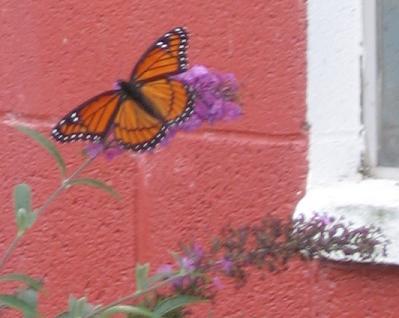BUGS,BUGS,BUGS!!!
| On one of your visits to Whitetail Wetlands you might luck out and be invited to one of the many butterfly or dragonfly counts. |
|
|
 |
| Great spangled fritillary on a butterfly bush |
|
|
 |
| Saffron-winged meadowhawk female |
|
|
| Or you might go along on a nighttime visit to the nearby forest for moth identification.
|
We try to include anyone who wants to learn about these wonderful creatures. Every summer the program includes children, many of whom approach the insects with some trepidation at first, but soon come to understand that most of the fear belongs on the insect's side.
|
 |
| Let's not forget the arachnids! Here, a garden weaver patches her web. By the way, this picture is about life-size. |
|
|
We've seen Yucks turn into Wows as the season progresses and pretty soon these children are handling the critters as if they were pets.
|
As people begin to understand that we would have no beauty in our environment without the insects, they start to respect all the work they do.
Helping with everything from pollination to decay, the creatures are essential to the wetlands and to virtually all environments.
They feed our fish, our birds, and at the same time, allow carcasses to decay faster and orchards to grow and bear fruit.
|
 |
| Honey Bee |
|
|
We study the Dragonflies and Damselflies with fascination. The beautiful colors, their aerial behavior, their agressive nature when protecting their territory are only a few of the characteristics that entice so many people every year to participate in the identification and observation of our Odonat population.
|
 |
| Hovering ruby meadowhawk. |
|
|
Butterfly counts are done throughout the summer and into fall. Our flower and herb gardens are pretty much planted to please the Lepidoptera.
|
 |
| Fritillaries in mass (yes, that IS what you think it is...) |
|
|
We observe everything from ants to honeybees, from butterflies and moths to cabbage worms and inch worms.
|
 |
| This hummingbird moth came to visit our petunias in the fall and stayed for weeks. The moth is a fooler...we had a guest here from Pittsburgh who came excitedly into the kitchen to tell me that we had a TINY little hummingbird on the porch! I hated to embarrass her but we are here to educate, right? |
|
|
 |
| This mourning cloak butterfly spreads his wings in the warming sun of an early spring afternoon after surviving a long cold winter sequestered under the bark of a tree. This brushfoot appears in early spring ready to find a mate and raise a family. |
|
|
 |
| Morning dew-jeweled web. |
|
|
 |
| Monarch butterflies travel from South America to the wetlands just for a bite of milkweed. They are large, bright colored and totally distasteful and , thus, have no problem with most birds. When they are at the height of their migration, large numbers can be seen, a totally delightful sight. |
|
|
 |
| Monarch on a butterfly bush. |
|
|
 |
| Busy at work on a new snare. |
|
|
 |
| Mating halloween pennants have formed a copulation wheel. Isn't love grand? |
|
|
|



